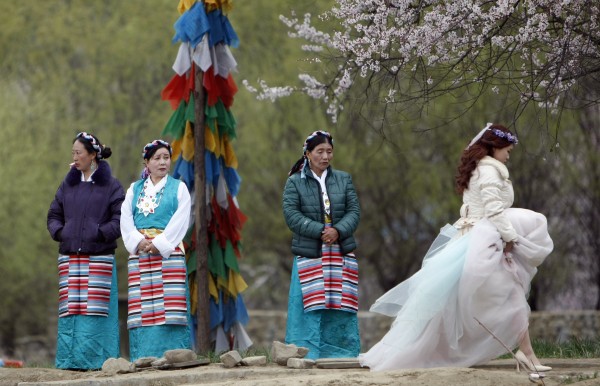China Promotes Intermarriage To Achieve Tibetan 'Unity'
| David Perry | | Aug 18, 2014 11:30 AM EDT |
(Photo : Reuters) A mobile court is bringing justice to people in the mountainous regions of China
Critics contend China has tried to stamp out the identity of Tibet through such heavy-handed means as exiling the Dalai Lama and imprisoning independence advocates. Now they worry a far more surreptitious tactic is being used - marriage.
Intermarriage between Han Chinese and Tibetans is on the rise, partially due to Beijing's open call for local Communist Party officials to more stridently promote such unions. The policy is a sharp change from the past, when intermarriage between Han and Tibetans was actively discouraged by power-brokers in Beijing.
Like Us on Facebook
"As the saying goes, 'blood is thicker than water,' we should make our ethnic relationship like that," said Chen Quanguo, the leading party official in Tibet, in June in the state-run Tibetan Daily newspaper. He added that leaders must "actively promote intermarriages."
Recent figures noted Tibet saw its mixed-marriage rates jump annually by double-digits over the past five years, from 666 couples in 2008 to 4,795 couples in 2013, although other numbers show a steady rise in mix-marriage divorce rates as well. China recognizes 56 ethnic groups within its borders, ranging from the Han majority to smaller groups including Uighurs, Koreans, and Manchus. Tibetan advocates claim officials such as Chen specifically push for marriages between ethnic Han and Tibetans, something government officials do not deny. The government calls Sino-Tibetans the "Unity Minority," but Tibet independence leaders charge the move is a ploy to further dilute the Tibetan national identity.
Unions between ethnicities circumvent China's famous One-Child Policy; interethnic couples are allowed up to three children, unlike their Han counterparts. However Chinese policy mandates parents to designate their ethnicity and that of their children. Parents of mixed backgrounds often identifiy their children as Han, believing it will clear hurdles minorities often face.
Because of the politics surrounding China's 60-year rule of the territory and its legality, exact population statistics for Tibetans in Tibet are sketchy. Opposing groups put forth numbers as low as three million and as high as over six million. While composing less than one percent of China's whole population of 1.35 billion, Tibetans are the vast majority in their native homeland, with estimates at around 90 percent.
Settling tensions between two groups through marriage has a long tradition, not just in China. Catherine of Aragon's marriage to Henry VIII of England was part of a treaty, as was the marriage between Louis-Auguste of France and his wife Maria Antonia of Austria, who changed her name to Marie Antoinette. The conscious blending of two entire ethnicities with government officials acting as matchmakers (something Chen advocates), however, is a hot-button issue in Tibet and other Chinese groups, the Han included.
Choekyi Gyaltsen, the tenth Panchen Lama, a position second only to the exiled Dalai Lama, set off a firestorm of ethnically-fueled criticism when he married Li Jie, the granddaughter of a Chinese general in 1979. Condemned as having been "politically rehabilitated" by communist establishment by his people, he was forced to leave his wife and child.
While promoted, Chinese-Tibetan marriages remain rare.
TagsTibet, marriage, Han Chinese, Tibetan weddings, Tibetan marriages, Mixed-race
©2015 Chinatopix All rights reserved. Do not reproduce without permission
EDITOR'S PICKS
-

Did the Trump administration just announce plans for a trade war with ‘hostile’ China and Russia?
-

US Senate passes Taiwan travel bill slammed by China
-

As Yan Sihong’s family grieves, here are other Chinese students who went missing abroad. Some have never been found
-

Beijing blasts Western critics who ‘smear China’ with the term sharp power
-

China Envoy Seeks to Defuse Tensions With U.S. as a Trade War Brews
-

Singapore's Deputy PM Provides Bitcoin Vote of Confidence Amid China's Blanket Bans
-

China warns investors over risks in overseas virtual currency trading
-

Chinese government most trustworthy: survey
-

Kashima Antlers On Course For Back-To-Back Titles
MOST POPULAR
LATEST NEWS
Zhou Yongkang: China's Former Security Chief Sentenced to Life in Prison

China's former Chief of the Ministry of Public Security, Zhou Yongkang, has been given a life sentence after he was found guilty of abusing his office, bribery and deliberately ... Full Article
TRENDING STORY

China Pork Prices Expected to Stabilize As The Supplies Recover

Elephone P9000 Smartphone is now on Sale on Amazon India

There's a Big Chance Cliffhangers Won't Still Be Resolved When Grey's Anatomy Season 13 Returns

Supreme Court Ruled on Samsung vs Apple Dispute for Patent Infringement

Microsoft Surface Pro 5 Rumors and Release Date: What is the Latest?










